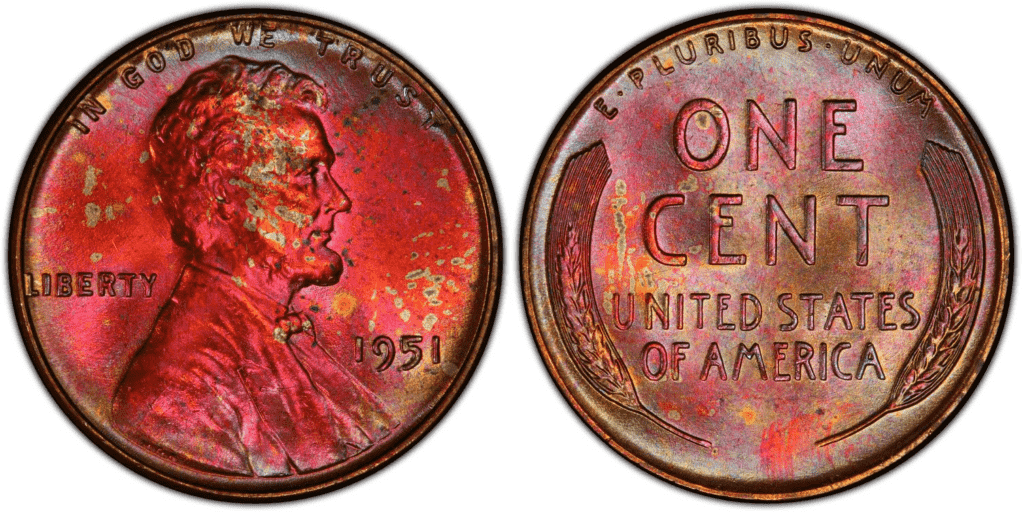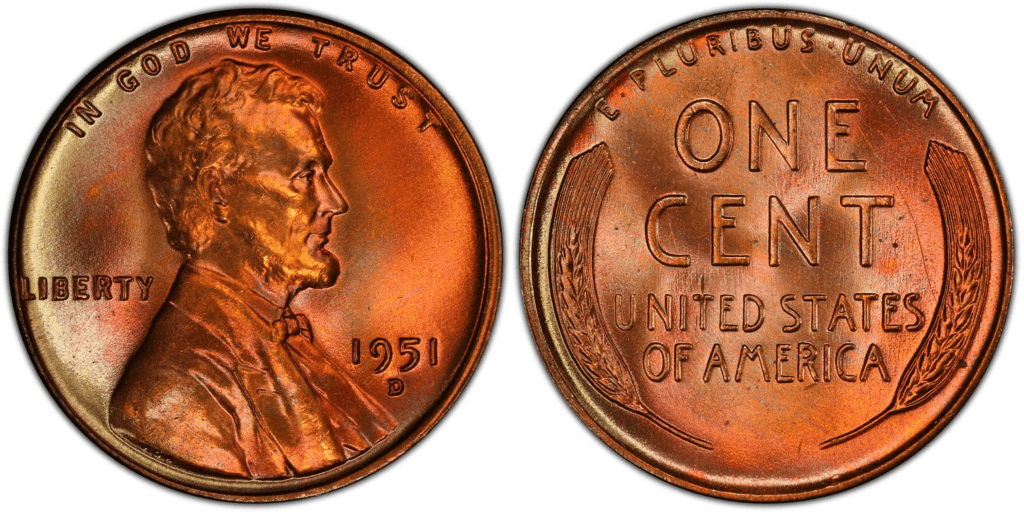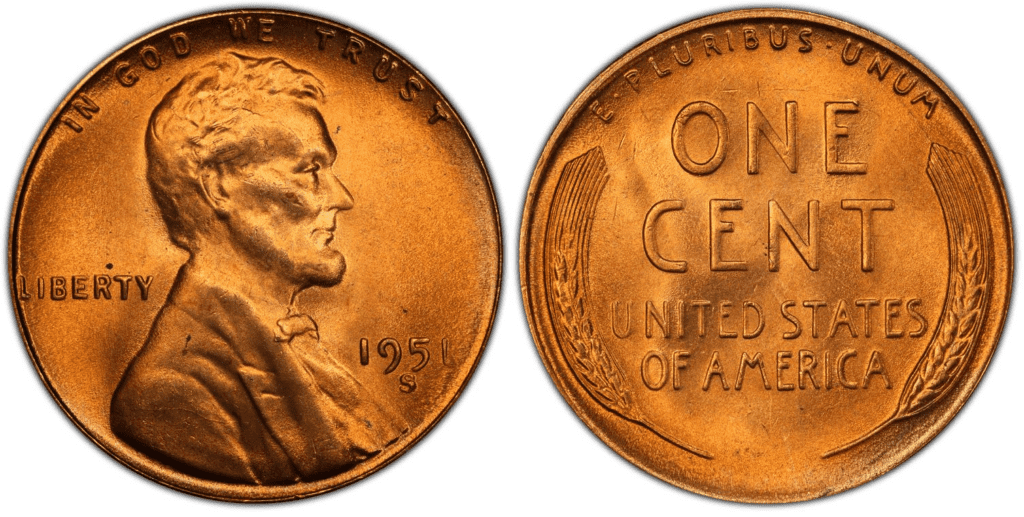What Is the 1951 Lincoln Wheat Penny Made Of?
The Lincoln cent, also known as the Lincoln penny, has a face value of $0.01. The U.S. Mint has struck this coin since 1909. The Lincoln penny has been produced for over a century now and is still in circulation up to the present. The mint has massively produced this coin since its circulation, and the 1951 Wheat Penny was made in the hundreds of millions.
The 1953 Lincoln Wheat Penny composition is 95% copper and 5% tin and zinc. The pennies produced from 1909 to 1942 and 1944 to 1982 have the same metal content. However, in 1943, the U.S. Mint struck Lincoln coins with zinc plated with steel. This was because, during the war, there were shortages of copper.
All coins minted from 1982 to now are made of 97.5% zinc and 2.5% copper.
The 1951 wheat pennies were made with a plain edge and a diameter of 19.05 mm. The weight, however, varies. For example, cents made from 1909 to 19,82 9 (i.e. including the 1951 series) weighed 3.11 grams, while the wartime steel coins were 2.7 grams. Currently, the one-cent coins weigh 2.5 grams.

photo source: USA Coin Book
For a bit of background, initially, the one cent’s design was a flying eagle created by sculptor Augustus Saint-Gaudens. Later, then-president Theodore Roosevelt learned that an eagle could not appear on the coin by law. So the coin had to be redesigned. But unfortunately, Saint-Gaudens became very ill and died without finishing the obverse design.
The inception of having Lincoln on the one-cent in 1909 happened when Roosevelt thought of honoring his fellow Republicans, as also was proposed by many citizens to the Treasury Department.
So in January 1909, the sculptor Victor David Brenner was commissioned for the coinage redesign to have Lincoln’s profile on the cent. That same year was also Lincoln’s centennial birth anniversary (he was born on February 12, 1809).
As you can see, the obverse (heads) design of the 1952 Wheat Penny shows the bust of the assassinated 16th U.S. President Abraham Lincoln facing right. The inscriptions on the obverse side also include the following:
- IN GOD WE TRUST
- LIBERTY
- 1951
On the reverse (tail), you can see two stalks of wheat placed on the left and right sides of the coin. The inscriptions include E PLURIBUS UNUM, ONE CENT, and UNITED AMERICA.
Brenner depicted two ears of durum wheat on the cent at that time, making the one-cent coins known for ‘wheat pennies’ struck from 1909 to 1958. In 1959, Brenner’s wheat was replaced with the Lincoln Memorial, designed by Frank Gasparro.
1951 Lincoln Wheat Penny Varieties
The production of the Lincoln wheat pennies, when you combine all varieties, was the 10th highest in 1951. The U.S. Mint produced about 1 billion combined coin varieties and released them into circulation.
The 1951 Penny has been struck at three mints in Philadelphia, Denver, and San Francisco. The known varieties of the 1951 Lincoln Wheat Penny from these mints are 1951-P, 1951-D, 1951-S, and 1951 Proof. Apart from these four, you can also find error coins of the 1951 Wheat pennies.
You can find more information about these varieties below:
1951 P Lincoln Wheat Penny
Edge: Plain
Mint Mark: No mintmark
Place of minting: Philadelphia
Year of minting: 1951
Face Value: $0.01 (one cent)
Price: $0.50 to $9 (or more)
Quantity produced: 284,576,000
Designer: Victor David Brenner
Composition: 95% Copper and 5% Tin and Zinc
Mass: 3.11 grams
Diameter: 19.05 mm

photo source: PCGS
There was ample production from the Philadelphia mint in 1951 of more than 284 million Wheat coins. As this is so, there are a lot of 1951-P rare varieties. Unfortunately, the average quality of these 1951 pennies was circulated and moderately worn.
1951 D Lincoln Wheat Penny
Edge: Plain
Mint Mark: D
Place of minting: Denver
Year of minting: 1951
Face Value: $0.01 (one cent)
Price: $0.50 to $12 (or more)
Quantity produced: 625,355,000
Designer: Victor David Brenner
Composition: 95% Copper and 5% Tin and Zinc
Mass: 3.11 grams
Diameter: 19.05 mm

photo source: PCGS
You would know that the 1951 wheat penny was struck at the Denver mint, as you can see a tiny “D” underneath the release year on the obverse face. That year there were more than 625 million wheat pennies produced for circulation.
Most Red (RD) 1951-D coin varieties tend to have a higher premium, especially when it retains 90% of its original copper shine. These coins are rare and closest to the orange-red color at the time of minting.
1951 S Lincoln Wheat Penny
Edge: Plain
Mint Mark: S
Place of minting: San Francisco
Year of minting: 1951
Face Value: $0.01 (one cent)
Price: $0.50 to $8 (or more)
Quantity produced: 136,010,000
Designer: Victor David Brenner
Composition: 95% Copper and 5% Tin and Zinc
Mass: 3.11 grams
Diameter: 19.05 mm

photo source: PCGS
The mint in San Francisco produced the fewest 1951 wheat penny coins among the three mints. There were about 136 million coins struck at the mint that year. Therefore, the “S” mark below the 1951 year on the obverse side pertains to the coin produced in San Francisco.
There was a massive production of the 1951-S Lincoln one-cent with MS66 grade. Coins with MS67 condition are much scarcer, while those above the MS67 grade are scarce.
1951 Lincoln Wheat Penny (Proof)
Edge: Plain
Mint Mark: No mint mark
Place of minting: Philadelphia
Year of minting: 1951
Face Value: $0.01 (one cent)
Price: $0.50 to $23 (or more)
Quantity produced: 57,500
Designer: Victor David Brenner
Composition: 95% Copper and 5% Tin and Zinc
Mass: 3.11 grams
Diameter: 19.05 mm

photo source: PCGS
The 1951 Proof Lincoln Penny is one of the most challenging to acquire from the Proof Lincoln one-cent series. It has a relatively low mintage compared to most other series. The PR67 samples are much scarcer, and a few PR68 or higher samples.
List Of 1951 Lincoln Wheat Penny Errors
There are over 1 billion 1951 Lincoln Wheat Penny minted and produced. Unfortunately, the equipment can overwork and deteriorate with these production numbers, resulting in min-made error coins. As these errors are mostly unintentional, the coins show some uniqueness and rarity. Distinct and special coins like these are valuable to many numismatists, as they can sell them reasonably.
There are many types of coin errors, some of them are:
- Die crack
- Rotated die
- Doubled die
- Clipped planchet
- Bank planchet
- Weak strike
- Off-center strike
- Broadstrike
- Lamination error
To give you an idea of what an error coin looks like, let’s take a look at a couple of examples below:
Doubled Die Error

photo source: eBay

photo source: eBay
This 1951-S over D Wheat Penny Error above is a doubled die (misspelling of the double die) date showing V on the United States of America on the reverse face. When the die or hub misaligns during the hubbing process, it can create duplicate design elements.
Doubled die strength varies from very light, isolated to extreme and widespread. Depending on the strength, this error can be visible to the naked eye.
Strike error

photo source: eBay
This example for the 1951 Lincoln Penny has a strike-on date error. The “1” in the 1951 year is not visible. This error happens when a planchet is stuck. The fault lies in the manufacturing process rather than the planchet or die. Prices of coins with strike errors are not as high as die-error coins.
How Much Is The 1951 Lincoln Wheat Penny Worth Today?
The latest pricing of the 1951 Lincoln Wheat Penny (with a face value of $0.01) is based on its grade, condition, and rarity. Its melting value will usually be based on the value of the metals it is made of: copper, tin, and zinc.
Today, the value of a 1951 Lincoln wheat cent is approximately $0.0249739. This is based on the price value of the 95% copper and 5% zinc mixture.
When it comes to the general value of the penny, it will also be based on its three types for each mintage year. So, for example, you can take a look at the value of these 1951 Lincoln pennies below:
| Coin | Condition | Grade | Mintage | Value |
| 1951 D Lincoln penny | Circulated/mint | Not graded | 625,355,000 | $0.012 to $0.35 |
| 1951 D Lincoln penny | Uncirculated/mint | MS-66 | 625,355,000 | $23 to $50 |
| 1951 D Lincoln penny | Uncirculated/mint | MS-67 | 625,355,000 | $100 to $228 |
| 1951 D Lincoln penny | Uncirculated/mint | MS-68 | 625,355,000 | $6,600 |
| 1951 P Lincoln penny | Circulated/mint | Not graded | 284,576,000 | $0.25 to $0.35
|
| 1951 P Lincoln penny | Uncirculated/mint | MS-65 | 284,576,000 | $11 to $26 |
| 1951 P Lincoln penny | Uncirculated/mint | MS-66 | 284,576,000 | $31 to $125 |
| 1951 P Lincoln penny | Uncirculated/mint | MS-67 | 284,576,000 | $408 to $900 |
| 1951 Proof Lincoln penny | Circulated/Proof | Not graded | 57,500 | $0.01 to $7.00 |
| 1951 Proof Lincoln penny | Uncirculated/Proof | PR-66 | 57,500 | $57 to $100 |
| 1951 Proof Lincoln penny | Uncirculated/Proof | PR-67 | 57,500 | $132 to $170 |
| 1951 Proof Lincoln penny | Uncirculated/Proof | PR-68 | 57,500 | $178 to $1,560 |
| 1951 Proof Lincoln penny | Cameo | PR-68 | 57,500
|
$2,350 to $9,988 |
| 1951 Proof Lincoln penny | Deep Cameo/Ultra Cameo | PR-67 | 57,500 | $15,920 |
| 1951 S Lincoln penny | Circulated/mint | Not graded | 136,010,000 | $0.30 to $0.50
|
| 1951 S Lincoln penny | Uncirculated/mint | MS-65 | 136,010,000 | $11 to $37 |
| 1951 S Lincoln penny | Uncirculated/mint | MS-66 | 136,010,000 | $27 to $36 |
| 1951 S Lincoln penny | Uncirculated/mint | MS-67 | 136,010,000 | $168 to $390 |
How Does The Grading System Work?
The Sheldon Scale is used by numismatists to provide a numerical value to coins. The Sheldon Scale goes from poor (P-1) to perfect mint state (P-1) (MS-70). Coins were originally evaluated using words to reflect their condition (Good, Fair, Excellent, Etc.). Unfortunately, coin collectors and dealers had different ideas about what each of these terms represent.
Professional numismatists joined together in the 1970s and established CoinGrading standards. These numismatists now assign grades at key places on the seventy-point scale, using the most regularly utilized numeric points in conjunction with the original adjective grade. The following are the most common coin grades:
-
-
- (P-1) Poor – Indistinguishable and probably damaged; if used, must have a date and mintmark; otherwise, rather battered.
- (FR-2) Fair – Nearly smooth, but without the damage that a coin graded Poor often possesses. The coin must have enough detail to be identified.
- (G-4) Fair – Inscriptions have merged into the rims in some areas, and important elements have been mostly erased.
- (VG-8) Very Good- A little weathered, but all of the primary design elements are visible, albeit faintly. There is little if any, central detail left.
- (F-12) Good – The item is very worn, yet the wear is even, and the overall design details stand out clearly. Rims are almost completely isolated from the field.
- (VF-20) Very Fine – Moderately weathered, with some finer features still visible. The motto or all letters of LIBERTY are readable. Both sides of the coin have entire rims that are separated from the field.
- (EF-40) Extremely Fine – Gently used; all gadgets are visible, and the most important ones are bold. The finer details are bold and clear, however, light wear may be seen.
- (AU-50) Uncirculated – Slight evidence of wear on the coin’s design’s high points; may have contact marks; eye appeal should be adequate.
- (AU-58) Uncirculated Choice – Slight traces of wear, no severe contact marks, almost full mint shine, and great eye appeal.
- (MS-60) Mint State Basal – Strictly uncirculated; no indication of wear on the coin’s highest points, but an unsightly coin with reduced luster, visible contact marks, hairlines, and other flaws.
- (MS-63) Mint State Acceptable – Uncirculated, but with contact scratches and nicks, little reduced shine, but otherwise appealing appearance. The strike is weak to average.
- (MS-65) Mint State Choice – Uncirculated with great mint shine, very little contact blemishes, and exceptional eye appeal. The strike is unusually severe.
- (MS-68) Mint State Premium Quality – Uncirculated with superb luster, no obvious contact marks to the naked eye, and exceptional eye appeal. The strike is quick and appealing.
- (MS-69) Almost Perfect Mint State – Uncirculated with perfect brilliance, a sharp and appealing strike, and extremely good eye appeal. A near-perfect coin with minor imperfections in the planchet, strike, and contact markings (seen only under 8x magnification).
- (MS-70) Mint State Perfect – Under 8x magnification, there are no tiny imperfections discernible; the strike is crisp, and the coin is perfectly centered on a beautiful planchet. Rarely seen on a coin, this coin is bright and whole, with original luster and exceptional eye appeal.
-
Where To Buy Or Sell 1951 Lincoln Wheat Penny?
You can typically find good quality 1951 Lincoln Wheat pennies on eBay and Amazon. Some sellers are also offering the coins via Etsy. These sites are good go-to places to sell your 1951 wheat pennies.
Physical stores like antique stores and pawnshops are your offline selling and buying options. In addition, coin shops and auction houses sell and buy different coin collections, including this 1951 Lincoln Wheat Penny.
Professionals from PCGS and NGC can also be your consultants if you need advice on how and what to go about when buying or selling your 1952 wheat pennies.
FAQs
What makes a 1951 D wheat penny valuable?
When it comes to Lincoln Cents, the Redder it is, the better; you can find three color distinctions in this coin. They are Red (RD), Red Brown (RB), and Brown (BN). Of the three, the most valuable of these is the color Red. As a result, most RD 1951-D are priced higher, especially when these coins retain their 90% original copper shine (closest to the orange-red color during minting).
What are the errors on a 1951 wheat penny?
Out of more than 1 billion 1951 Lincoln Wheat Penny produced, several error coins occurred during the minting process. Some known error coins can be found on eBay and other sites like Etsy.
To list a few, you can find these types of error coins for the 1952 wheat penny online:
- Clipped planchet
- Misaligned dies
- Doubled die
- Strike error
- Off-center strike
- Punch error (repunched)
Is there a rare vintage 1951 D wheat penny?
While we can’t conclude it’s the rarest vintage penny of all, there’s a 1951-D wheat penny on eBay labeled vintage rare and sold at around $12,000 (currently on sale at $2,400). The redder the coin is, the more rare and expensive the Denver-minted coin has it.







